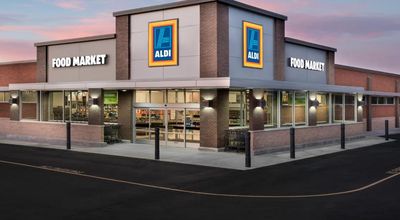The remodeling comes as supermarkets are competing fiercely with Wal-Mart and Amazon to draw customers with lower prices, streamlined selections and even services like delivery. Aldi’s plans may allow it to steal share from foodie favorites such as Whole Foods Market Inc. and Trader Joe’s, which is controlled by a different bloc of the Albrecht clan.
Aldi hopes to draw about 60 million shoppers a month by 2020, up from about 40 million currently, but it faces an uphill climb. U.S. grocery industry sales are projected to increase only 0.2 percent this year to about $612 billion, according to researcher IBISWorld. And revenue is forecast to gain 1 percent or less for the next five years after that.

“There’s limited growth,” said Jim Sanderson, managing director at Arthur W. Wood Co., an investment firm. “For the typical U.S. grocery store, there’s just too much square footage right now.”
Even so, there’s still room for private-label chains like Aldi to expand, Sanderson said. The chain is projected to reach $12 billion in revenue this year, up from $11 billion two years ago, according to IBISWorld.
“You’ve got under-penetration of the hard discounters, which is what Aldi is,” he said.
About 300 Aldi stores in the U.S. already have the new look. The upgrades include sleeker refrigerator doors and windows to bring in more natural light. The company is widening the first aisle, expanding the front of the store and raising ceilings by as much as six feet (1.8 meters). The stores also are about 20 percent larger, allowing Aldi to add more items to its quickly growing lines of organic produce, fresh meat and alcohol.
The wine is housed in fancier wood fixtures with spotlights. A picture by the fresh meat shows a rare-cooked steak being cut and seasoned.
“It’s a modern shopping experience,” Hart said.
Family Business
Aldi was founded more than a century ago when Anna Albrecht opened a small store in Essen, Germany. Her sons, Karl and Theo, took over in 1948 and quickly expanded. In 1962, the name became Aldi, shortened from Albrecht Discount. That same year, the brothers split the chain into two companies — Aldi Süd and Aldi Nord — following a dispute about whether to sell cigarettes. Aldi Süd oversees the U.S. operations.
The closely held company opened its first U.S. store in 1976 in Iowa. It expanded in the Midwest before moving into other parts of the country, including the debut of its first California store last year. The grocer has said it will reach 2,000 locations nationwide by the end of next year.
That pits Aldi against established West Coast favorites Trader Joe’s and Sprouts Farmers Market Inc. The moves also will place it in direct competition with Whole Foods, which has struggled lately to boost sales as more retailers sell organic and natural fare. Last year in Los Angeles, Whole Foods opened the first of its smaller, lower-priced stores called 365.
Over the past three years, Aldi has ramped up its organic offerings, too, featuring a private-label line called SimplyNature, whose sales jumped about 54 percent last year to more than $300 million. The brand includes items such as coconut oil, cereals, almond butter and produce.
With its no-frills approach — bag-your-own groceries, 25-cent cart rentals, giant quick-to-scan bar codes — Aldi has managed to sell its wares for less than others. It advertises that customers can save up to 50 percent by shopping there. And the chain won’t be raising its signature low prices to pay for the remodels, Hart said.
“Although they are trying to add more organic options and things like that, it’s important to keep the customers they have,” said Madeline Hurley, an analyst at IBISWorld. “The balance is crucial.”
by Leslie Patton Source: Bloomberg, February 2017
